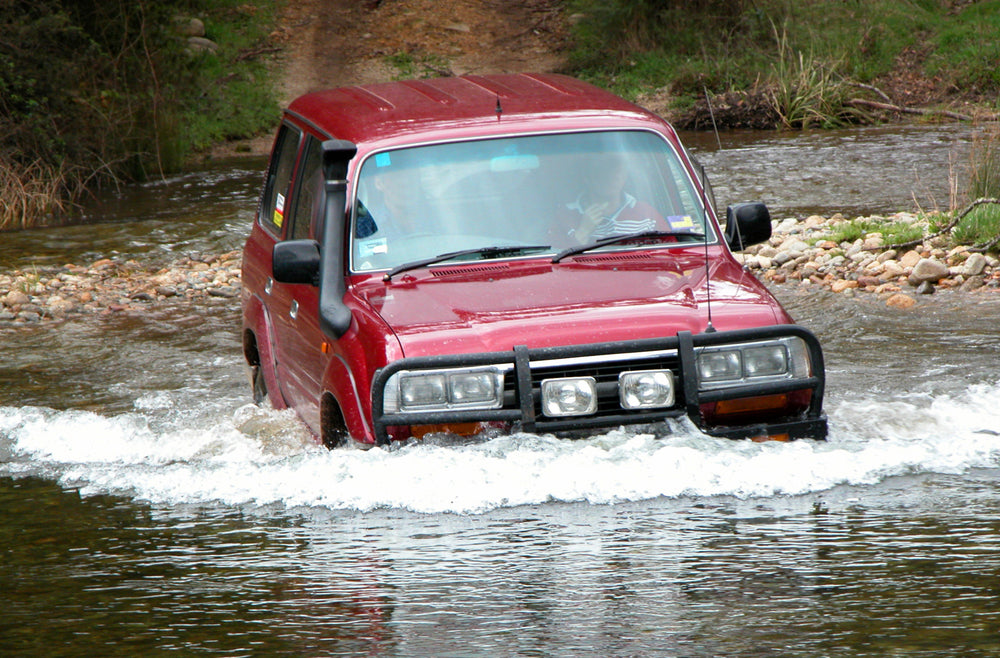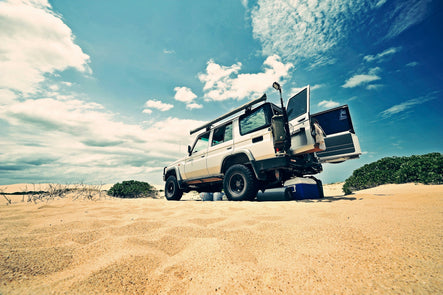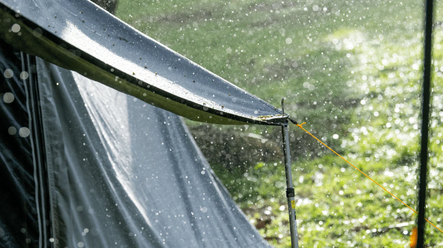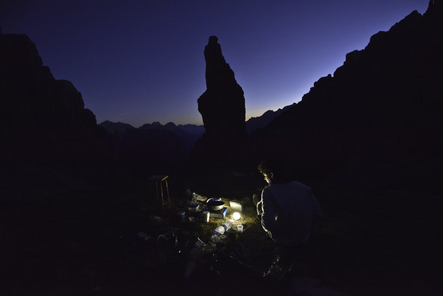Aside from their rugged aesthetic appeal, bull bars are a popular addition to boost a 4WD's off-road performance and protection. But to fit or not to fit? That is the question. The answer largely depends on where and how you use your vehicle.
If you're an adventure seeker venturing off the beaten path, bull bars are often seen as an excellent aftermarket addition. On the flip side, major motoring organisations and regulatory bodies generally agree on one thing - in densely populated cities and suburban areas, bull bars have no place on vehicles.
In this article, we'll explore the pros and cons of fitting bull bars to your vehicle. And to keep things concise, we'll use "bull bars" as an umbrella term that encompasses roo bars and nudge bars as well.
What is a Bull Bar?
Often seen attached on the front of 4WDs and utility vehicles, a bull bar is a tough steel bar, often large in shape with parallel tube bars joined together to form a protective structure. The design and construction of bull bars can vary, but the primary function remains the same: reinforcing the vehicle's durability and safeguarding against potential damage.

Pros: Delving into the Benefits of Bull Bars for Your 4WD
In this section, we'll be taking a closer look at the various advantages of installing a bull bar, providing you with a more in-depth understanding of the multitude of benefits that come with this popular 4WD accessory.
1. Pros of Installing a Bull Bar: Enhanced Vehicle Protection
One of the primary reasons for installing a bull bar on your 4WD or ute is to provide an extra layer of protection for your vehicle's front end. Venturing off-road can often lead to encounters with obstacles such as rocks, tree branches, and wildlife.
A sturdy bull bar can effectively shield your vehicle's most vulnerable components, such as the radiator and headlights, from potential damage. This additional level of protection can save you from costly repair bills and keep your 4WD in top shape for those unpredictable off-road conditions. From cosmetic damage to major incidents, a reliable bull bar acts as an added barrier, providing peace of mind and preserving the integrity of your vehicle.
2. Pros of Installing a Bull Bar: Recovery Point and Winch Integration
A bull bar also serves as an ideal mounting point for essential recovery equipment, such as winches and recovery points. This integration allows for more efficient and safer vehicle recoveries in challenging situations, which can be a lifesaver when you find yourself bogged down in mud or stranded in a remote location.
By combining the functionality of a recovery point and winch with the structural support of a bull bar, you'll have a versatile, all-in-one solution that's ready to tackle any off-road challenge.
3. Pros of Installing a Bull Bar: Improved Off-Road Capability
The installation of a bull bar can significantly improve your 4WD's off-road capability by providing increased ground clearance and approach angles. These improvements allow your vehicle to more easily navigate steep inclines, uneven terrain, and obstacles, giving you the confidence to tackle even the most rugged off-road trails.
Furthermore, the added structural support of a bull bar can help to prevent chassis damage and deformation, ensuring your vehicle remains in top condition throughout your off-road adventures.
4. Pros of Installing a Bull Bar: Customisation and Accessory Mounting Options
A bull bar offers a wealth of customisation options, enabling you to tailor your 4WD to suit your specific off-road needs and preferences. This includes the ability to mount various accessories, such as driving lights, UHF antennae, and sand flags, directly onto the bull bar.
By consolidating these accessories onto a single, sturdy platform, you can maximise your vehicle's off-road functionality while maintaining a clean and uncluttered appearance.
5. Pros of Installing a Bull Bar: Aesthetic Appeal
Last but not least, a well-designed bull bar can add a touch of rugged style and personality to your 4WD. In addition to its practical benefits, a bull bar can enhance the overall look of your vehicle, giving it a more impressive and off-road-ready appearance.
With a wide range of designs and finishes available, you're sure to find the perfect bull bar to complement your 4WD and reflect your personal style.
Pros of Installing a Bull Bar: The Takeaway
Installing a bull bar on your 4WD offers a range of practical and aesthetic benefits, from enhanced vehicle protection and off-road capability to customisation and accessory mounting options.
At the forefront of considerations, a solid bull bar can absorb the impact of collisions with trees, rocks, and other obstacles you may encounter during off-road adventures. This not only helps minimise damage to your vehicle's front end, but also reduces the risk of costly repairs and downtime.
By carefully considering these advantages in relation to your specific needs and preferences, you can make an informed decision about whether a bull bar is the right addition to your off-road setup.
Cons of Installing a Bull Bar: Weighing the Downsides
While there are numerous advantages to fitting a bull bar to your 4WD, it's essential to consider the potential drawbacks before making a decision. In this section, we'll talk about the cons of installing a bull bar, covering concerns such as increased vehicle weight, fuel consumption, and more.
1. Cons of Installing a Bull Bar: Increased Vehicle Weight and Fuel Consumption
One of the main concerns when installing a bull bar is the additional weight it adds to your vehicle. This extra weight can impact your vehicle's performance and fuel efficiency, potentially leading to higher fuel costs in the long run.
In rare cases, the increased weight could impact your vehicle's suspension, making it essential to ensure your 4WD's suspension is up to the task of handling the additional load. And while there are lightweight bull bar options available, it's worth weighing up the benefits and drawbacks of different materials and designs to find the right balance for your needs.
2. Cons of Installing a Bull Bar: Environmental Impact
The impact of increased fuel consumption extends beyond just your wallet—it also has implications for the environment. As mentioned above, bull bars add weight to your vehicle. The additional weight can lead to increased fuel consumption and emissions. The engine has to work harder to move the heavier vehicle, resulting in reduced fuel efficiency and higher carbon dioxide (CO2) emissions.
While bull bars provide protection and durability, it's important to consider the potential trade-off in terms of environmental impact. If minimising your carbon footprint is a priority, you may want to reconsider adding a bull bar to your 4WD or ute.
3. Cons of Installing a Bull Bar: Potential Interference with Vehicle Safety Features
Modern 4WD vehicles often come equipped with advanced safety features such as parking sensors, adaptive cruise control, and autonomous emergency braking systems. Installing a bull bar could interfere with these features, potentially reducing their effectiveness and putting you at risk in certain situations. Before installing a bull bar, check with your vehicle's manufacturer to ensure compatibility and avoid compromising your vehicle's safety systems.
In congested urban areas, bull bars are considered a safety hazard. These bulky structures can hinder driver visibility and increase the chances of additional collisions when quick reactions and precise movements are necessary, like avoiding sudden obstacles or pedestrians.
4. Cons of Installing a Bull Bar: Legal and Compliance Considerations
In Australia, there are strict regulations governing the design and fitment of bull bars to ensure they meet safety standards and don't pose a risk to other road users. To remain compliant, it's in everyone's best interest to choose a bull bar that meets the Australian Design Rules and is deemed appropriate for your specific vehicle. Failing to comply with these regulations could result in fines, voided warranties, and potential issues with your insurance coverage.
5. Cons of Installing a Bull Bar: Cost of Purchase and Installation
Finally, the financial investment involved in purchasing and installing a bull bar on your 4WD can be a hefty one. The higher quality of the bull bar, the higher the price tag, and professional installation can add to the expense.
While it may be tempting to opt for a cheaper option or DIY installation, it's crucial to ensure the bull bar is fitted correctly and securely to avoid compromising its performance and your vehicle's safety. In addition, consider the potential long-term costs associated with increased fuel consumption and any potential impact on your vehicle's warranty or resale value.
Cons of Installing a Bull Bar: The Takeaway
Before jumping on the bull bar bandwagon, it's a smart move to carefully weigh the pros and cons of installing a bull bar on your 4WD, considering factors such as vehicle weight, fuel consumption, safety feature compatibility, legal compliance, and cost. These factors may deter some 4WD owners from choosing to install a bull bar, particularly if they primarily use their vehicle for urban driving or are concerned about the environmental impact.
Depending on individual circumstances, what is considered a dealbreaker may differ from person to person.
Other Things to Consider Before Purchasing a Bull Bar
While going through the pros and cons of bull bars, it's important to keep your specific needs and preferences in mind as well as all the different types of bull bars out there. Factors such as your vehicle's make and model, your off-roading habits, and your budget will all play a role in determining the best course of action.
Bull Bar Materials and Design
When it comes to choosing the right type of bull bar for your 4WD, there are several factors to consider, including materials and design. Design-wise, bull bars should have no sharp edges and are typically made from steel, aluminium, or plastic, each offering its own set of benefits and drawbacks.
Steel Bull Bars
Steel bull bars are known for their durability and strength, making them an excellent choice for those who frequently tackle rough off-road terrain. However, they can be quite heavy, which may impact your vehicle's performance and fuel efficiency.
Aluminium Bull Bars
On the other hand, aluminium bull bars are lightweight and corrosion-resistant, but they may not offer the same level of protection as their steel counterparts.
Plastic Bull Bars
Lastly, plastic bull bars are the lightest of all, but their durability and strength are often inferior to metal options.
When selecting a bull bar design, consider your 4WD's specific needs and usage patterns. For example, if you regularly drive in areas with a high risk of animal collisions, a full-width bull bar may be the best choice to provide maximum protection. On the other hand, if you're focused on improving your vehicle's off-road capabilities, a winch-compatible bull bar may be the way to go.
Is the Bull Bar Airbag Compatible?
When it comes to your vehicle's airbags and the bull bar you choose, it's important to make sure they work together. If your vehicle already has airbags, you'll want to ensure that the bull bar you buy has a mounting system that's compatible with them.
Manufacturers usually state which bull bar models are airbag compatible (the bar mounts are designed to crush in compression) and which ones aren't. Some even conduct real-world crash tests to ensure the best compatibility. Others rely on computer simulations. If you're worried, just reach out to the bull bar manufacturer and ask how they test for airbag compatibility.
Checking for airbag compatibility helps ensure your safety on the road. It's worth taking the time to find a bull bar that not only looks good on your vehicle but also works seamlessly with your airbags in case of an accident.
The Strength and Durability of the Bull Bar
A bull bar should be strong enough to handle unexpected encounters on the road such as animal impacts and minor collisions. When choosing a bull bar, look for reputable brands known for their strength and durability. Consider factors such as the materials used, the construction technique, and any additional features that enhance its protective capabilities. Taking the time to select a reliable and robust bull bar will ensure that it can effectively handle animal impacts and minor collisions, providing you with added confidence during your journeys.
When you're driving in areas where wildlife crossings are common, the robust construction of a bull bar provides an added layer of protection. It can absorb and distribute the force of impact, reducing the risk of damage to your vehicle and, more importantly, keeping you and your passengers safe.
By investing in a high-quality bull bar, you can have peace of mind knowing that your vehicle is better equipped to handle unexpected encounters on the road. However, it's important to remember that while bull bars offer protection, they are not a guarantee against all types of collisions. Safe and responsible driving practices should always be followed to minimise the risk of accidents.
Individual Lifestyle and Driving Habits
What kind of driver are you? To determine whether a bull bar is the right choice for your 4WD, it's essential to carefully consider your individual needs, preferences, and driving habits. Here are a few questions to think about:
- How often do you venture off-road, and what kind of terrain do you typically encounter?
- Have you experienced any incidents in the past that may have been mitigated by the presence of a bull bar?
- Are you interested in customisation options, such as mounting additional accessories like driving lights or antennas?
- How concerned are you about the potential impact on fuel consumption and vehicle weight?
-
Are you willing to invest in a quality bull bar and professional installation to ensure optimal performance and safety?
FAQ Section: Navigating Bull Bars and Their Uses
Q: Can you fit a winch without a bull bar?
A: While it is possible to fit a winch without a bull bar, it may not be the most efficient or secure option. A bull bar provides a sturdy mounting point for a winch, ensuring it is securely fastened and can handle the stress of vehicle recovery. Alternative mounting options, such as custom brackets or plating, may be less reliable and could put additional strain on your vehicle's chassis.
Q: Do you need a bull bar for recovery points?
A bull bar is not the only option for adding recovery points to your 4WD, but it does offer a convenient and sturdy solution. Some vehicles have pre-installed recovery points on their chassis, while others may require the installation of aftermarket recovery points. A bull bar combines the benefits of a recovery point with additional vehicle protection, making it a popular choice for off-road enthusiasts.
Q: Why do people use bull bars?
A: Bull bars serve multiple purposes for 4WD owners. They offer enhanced vehicle protection against potential impacts, provide a sturdy mounting point for recovery gear and winches, improve off-road capabilities, and allow for the mounting of additional accessories such as driving lights and antennas. Additionally, many 4WD enthusiasts appreciate the rugged, tough appearance that bull bars add to their vehicles.
Q: What's the point of a bull bar?
A: The primary purpose of a bull bar is to protect the front end of your vehicle from potential damage during off-road adventures or in the event of a collision with wildlife. Additionally, bull bars serve as a convenient mounting platform for recovery gear, winches, and other accessories, as well as enhancing the overall aesthetic and off-road capabilities of your 4WD.
Q: Does a bull bar help in a crash?
While bull bars can provide some protection in the event of a crash, their primary function is to protect your vehicle from damage during off-road activities. It's important to note that bull bars may interfere with certain vehicle safety features, such as airbags and crumple zones, which could impact their effectiveness in a collision.
Q: What are the disadvantages of a bull bar?
The main disadvantages of a bull bar include increased vehicle weight, which can lead to higher fuel consumption, potential interference with vehicle safety features, and the need to ensure legal compliance with local regulations. Additionally, the cost of purchasing and installing a bull bar can be a significant investment for some 4WD owners.
Q: Is it worth getting a bull bar?
Determining whether a bull bar is worth the investment depends on your individual needs and preferences. If you frequently embark on off-road adventures, require a secure mounting point for a winch or recovery gear, or desire the aesthetic appeal of a bull bar, it may be a valuable addition to your 4WD.
Q: Do you need a bull bar on a 4WD?
A bull bar is not a mandatory accessory for a 4WD, but it can offer numerous advantages for off-road enthusiasts. Ultimately, the decision to install a bull bar on your 4WD will depend on your specific needs, preferences, and how you plan to use your vehicle. By understanding the pros and cons of bull bars, you can make an informed decision that best suits your 4WD and adventures.
Making the Right Decision: Should You Install a Bull Bar on Your 4WD?
Clearly, there's more to bull bars than meets the eye. Whether you're a suburban sophisticate or mountains are more your scene, understanding the in and outs of installing a bull bar allows you to make the final call.
On the pros side, installing a bull bar can offer numerous benefits, such as shielding it from potential damage, recovery point and winch integration, improved off-road capability, customisation options, and added aesthetic appeal. These advantages can provide peace of mind, particularly if you frequently embark on off-road escapades or travel through remote areas with unpredictable road conditions.
As mentioned, there are a few potential drawbacks to consider as well. Installing a bull bar can increase your vehicle's weight and fuel consumption, which might be a deal-breaker for some. Additionally, there's the potential interference with vehicle safety features, as well as legal and compliance considerations that may vary depending on your location. Not to mention the cost of purchase and installation, which can also be a deciding factor.
At the end of the day, what constitutes a dealbreaker when installing a bull bar on a 4WD boils down to individual priorities, legal considerations, safety concerns, performance preferences, and aesthetic choices. By weighing the pros and cons, you can make an informed decision and equip your 4WD with a bull bar that not only looks great but also serves its intended purpose. Happy trails!
Oz Camping Adventures: The Home of 4WD Camping Accessories
We invite you to visit our indoor showroom and explore our impressive collection of 4x4 and RV accessories. At our showroom, you can witness firsthand the high quality and wide variety of products we offer. Book a viewing or demonstration to get a closer look and experience our accessories in action.
Or, if you’re feeling inspired and want to chat all about bull bars and bull bar installation in Melbourne, give us a call - 03 9708 2946.







